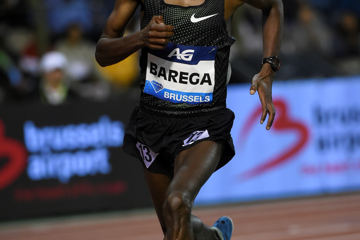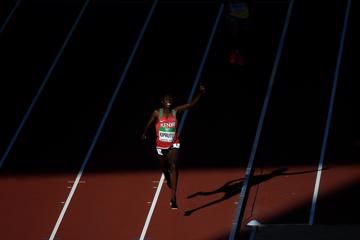Sondre Moen
This sport can be lonely, but that’s not always a bad thing.
Don’t get me wrong: when I’m training at altitude in Sestriere, Italy, barely speaking to anyone but my coach for months on end, you do question yourself just a little.
Or when you get injured, and all your hard work goes to waste because of a stress fracture, a tendon tear, there’s no lonelier place to be as an athlete. But sometimes, being alone is a good thing. It toughens you up, makes you mentally stronger for all the battles we face on the track or on the roads.
As a teenager, growing up in Norway, I aspired to be a cross-country skier. At the age of 16 I left it behind me, though, and chose distance-running.
At the time there was no real training environment for high-level distance runners in Norway so in the years that followed, most of my training was done alone.
There are positives and negatives to that. When you have to do faster stuff on the track it’s good to have someone to push you but for long runs and threshold stuff, I find it easy to go through the work and switch off the brain when I’m alone, to focus on nothing else but not letting the pain enter the brain.
My biggest breakthrough actually came after one of those periods. After the Rio Olympics in 2016, where I finished 19th in the marathon, I changed coaches to Renato Canova, an Italian who spends a lot of the year in Kenya.
That Autumn he was based at home in Turin and even though it was tough to move to altitude on my own, I thought it was more important that he could follow my training in person. In September, October, Sestriere is like a ghost town with just one supermarket and one coffee shop that's open, so for those seven weeks he was about the only person I saw.
The following January, I went to Kenya to train for a couple of months and that was where I made not just a physical breakthrough, but a big mental one. I had first gone there in 2009 with other Norwegians but that time, we trained with each other and didn’t integrate that much.
This time, I was training with some of the best, athletes faster than me but close enough to be able to run with on most sessions. Over those months I could see I was closing the gap and I started to believe more in myself more. I also stopped believing what people at home were saying: that 62 minutes for the half marathon is very hard or that 2:10, 2:12 for a marathon is very fast.
For many years, I’d been used to high-volume training and it all prepared me for the level I’d face when training with some of top Kenyans.
I remember looking back at a training diary from when I was 18 and seeing that I ran 1037 kilometres (644 miles) in a month. In 2014, 2015, 2016 I had many weeks of 200-220km per week. That laid a great foundation for what came next.
But I made mistakes – lots of them. In 2015 I was doing that training while working 30-40 hours a week, on my feet for eight hours a day, and I burnt out that year, fried my system. But you learn from it.
I missed almost two years after I tore my flexor hallucis longus tendon in 2012 and when I’m injured like that, I realise how quickly this can all be taken away. It makes you appreciate the good days all the more.
In 2017, a lot of things came together ahead of the Fukuoka Marathon. Renato Canova is more like a tailor than a coach – it's never one size fits all – and when I went to him he said my 5K PB is six years old and we need to improve my basic speed, so we did. I had already built a huge base and at the age of 25, I had to accept that my training had to change. Without Renato, I would never have been able to take the next step.
That next level was what happened in Fukuoka: a European record of 2:05:48 to win, the best performance of my life. After a run like that, you feel on top of the world and start planning how you might be able to win medals at Europeans, World Championships, Olympics.
But what I didn’t do is what I now know I should have done: tread carefully.
When you hit that high level it’s easy to forget the small things that count for so much: the stretching and core exercises that ensure your body is able to handle all the volume. It can be a lot to absorb.
In my typical marathon build-up, I’ll run about 200-220km a week and can sometimes go as high as 240km. I do one track workout a week – about 12-18km of volume at 10K or half marathon pace – then one long run of 35-40km at an even tempo, about 80-85 percent of goal marathon pace.
I’ll also do some long runs alternating 3-6km at marathon pace with 1km moderate (about 10-15% slower than marathon pace) and once in my build-up, I’ll do 35-40km at 95 percent of marathon pace, which feels like a race itself – you need a few easy days before and after.
At times, I’ve pushed too far and paid the price. Last year I got a tendon tear in the attachment of my adductor longus which forced me to drop out of the European Championships and I only discovered in October that it was a 20 percent tear of the tendon. After that I took two months off and started back, but in April this year I got a stress fracture in my sacrum.
Another six weeks off.
I had been planning to break my 10,000m personal best on the track in Stanford in May but that injury stopped everything. Instead I went back to my roots, did some cross-country skiing as cross training, and got back running properly in June.
I wasn’t at my best, but as the summer went on I surprised myself, finishing second in the famed Giro di Castelbuono road race in Italy before running the Norwegian 10,000m record last month: 27:24.78.
Since then I’ve been back training in Sestriere, where the routine is the same most days: wake up at 7am, have a light breakfast and run after it gets bright around 8:30 or 9am. After that I stretch, maybe hit the gym, then have lunch at 12:30. I sleep for an hour or two, have a coffee around 3, do an easy run around 4, with more stretching after. Dinner is at 7:30, and I’m in bed at 9:30.
It’s a simple life, not the most exciting, but it’s easy to enjoy as long as you see the progression. Once I see that, little else matters. This time, thankfully, I have a Danish friend to train with so it’s not so isolated, and my spare time is spent reading books or watching Netflix.
And now it’s time to return to my favourite distances: the longer ones. After last weekend's Copenhagen Half Marathon, the next big target is the Valencia Half Marathon in late October followed by the Valencia Marathon in early December.
When I look ahead, there are times I believe I can run if everything comes together: sub-59 for the half-marathon and sub-2:04 for the marathon. I can’t control what others are doing – maybe 10 East Africans will run 2:01 or 2:02 in the years ahead, I don't know – but what I can focus on is me.
If I get things right, whether I win major medals or not, I'll be able to walk away knowing I gave it my all.
Images: Giovanni Certomà, Giro di Castelbuono/Thijs Nijhuis







